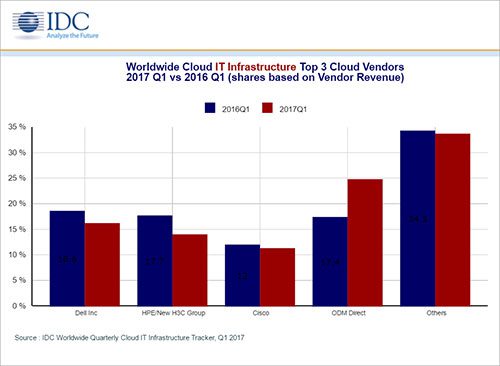The cloud’s insatiable appetite for faster servers, bigger storage and high-performance networking, is lifting the fortunes of many technology vendors. In fact, sales of cloud IT infrastructure now represents nearly two fifths of all IT spending, according to technology research firm IDC. During the first quarter (Q1) of 2017, vendors of cloud IT infrastructure – […]
Datamation content and product recommendations are
editorially independent. We may make money when you click on links
to our partners.
Learn More
The cloud’s insatiable appetite for faster servers, bigger storage and high-performance networking, is lifting the fortunes of many technology vendors. In fact, sales of cloud IT infrastructure now represents nearly two fifths of all IT spending, according to technology research firm IDC.
During the first quarter (Q1) of 2017, vendors of cloud IT infrastructure – a category that includes servers, storage systems and Ethernet switching equipment – generated $8 billion in revenue, a 14.9 percent year-over-year increase. As a share of all IT spending worldwide, the category accounts for 39 percent compared to 33.9 percent in Q1 2016.
Cloud Storage and Backup Benefits
Protecting your company’s data is critical. Cloud storage with automated backup is scalable, flexible and provides peace of mind. Cobalt Iron’s enterprise-grade backup and recovery solution is known for its hands-free automation and reliability, at a lower cost. Cloud backup that just works.
SCHEDULE FREE CONSULT/DEMO
This year provided a strong start for vendors that cater to public and private cloud providers, noted IDC research director Natalya Yezhkova.

“After a weak performance during 2016, storage purchases for cloud IT environments had a strong rebound in the first quarter, driving the overall growth in this segment,” said Yezhkova in a statement. “Overall, the first quarter set a strong beginning of the year for the cloud IT infrastructure market. With positive dynamics in purchasing activity by hyperscalers across all technology segments we expect a strong year ahead for the fastest growing public cloud segment.”
Sales to public cloud providers jumped 21.7 percent on an annual basis to $4.8 billion in Q1 2017. Private cloud revenues clocked in at $3.1 billion, a six percent increase. Meanwhile, non-cloud infrastructure sales dipped eight percent.
Dell is the cloud IT infrastructure leader with 16.2 percent of the market and nearly $1.3 billion in revenue last quarter. Hewlett Packard Enterprise (HPE) and its New H3 Group joint venture are a close second with $1.1 billion in revenue and 14 percent of the market. Third place Cisco generated sales of $902 million in Q1, enough for an 11.3-percent share of the market.
Original design manufacturers (ODMs) that sell directly to cloud providers experienced massive revenue growth last quarter. Collectively, ODMs sold nearly $2 billion in cloud IT infrastructure, a 64.1-percent year-over-year increase.
Public cloud providers flocked to data storage systems, increasing sales by 49.5 percent in Q1 2017 compared to the same year-ago quarter, followed by Ethernet switches (22.7 percent) and servers (8.7 percent). On the private cloud front, the Ethernet switch segment experienced the most growth (15.5 percent), followed by storage (10 percent) and servers (2.1 percent).
Pedro Hernandez is a contributing editor at Datamation. Follow him on Twitter @ecoINSITE.
-
Ethics and Artificial Intelligence: Driving Greater Equality
FEATURE | By James Maguire,
December 16, 2020
-
AI vs. Machine Learning vs. Deep Learning
FEATURE | By Cynthia Harvey,
December 11, 2020
-
Huawei’s AI Update: Things Are Moving Faster Than We Think
FEATURE | By Rob Enderle,
December 04, 2020
-
Keeping Machine Learning Algorithms Honest in the ‘Ethics-First’ Era
ARTIFICIAL INTELLIGENCE | By Guest Author,
November 18, 2020
-
Key Trends in Chatbots and RPA
FEATURE | By Guest Author,
November 10, 2020
-
Top 10 AIOps Companies
FEATURE | By Samuel Greengard,
November 05, 2020
-
What is Text Analysis?
ARTIFICIAL INTELLIGENCE | By Guest Author,
November 02, 2020
-
How Intel’s Work With Autonomous Cars Could Redefine General Purpose AI
ARTIFICIAL INTELLIGENCE | By Rob Enderle,
October 29, 2020
-
Dell Technologies World: Weaving Together Human And Machine Interaction For AI And Robotics
ARTIFICIAL INTELLIGENCE | By Rob Enderle,
October 23, 2020
-
The Super Moderator, or How IBM Project Debater Could Save Social Media
FEATURE | By Rob Enderle,
October 16, 2020
-
Top 10 Chatbot Platforms
FEATURE | By Cynthia Harvey,
October 07, 2020
-
Finding a Career Path in AI
ARTIFICIAL INTELLIGENCE | By Guest Author,
October 05, 2020
-
CIOs Discuss the Promise of AI and Data Science
FEATURE | By Guest Author,
September 25, 2020
-
Microsoft Is Building An AI Product That Could Predict The Future
FEATURE | By Rob Enderle,
September 25, 2020
-
Top 10 Machine Learning Companies 2021
FEATURE | By Cynthia Harvey,
September 22, 2020
-
NVIDIA and ARM: Massively Changing The AI Landscape
ARTIFICIAL INTELLIGENCE | By Rob Enderle,
September 18, 2020
-
Continuous Intelligence: Expert Discussion [Video and Podcast]
ARTIFICIAL INTELLIGENCE | By James Maguire,
September 14, 2020
-
Artificial Intelligence: Governance and Ethics [Video]
ARTIFICIAL INTELLIGENCE | By James Maguire,
September 13, 2020
-
IBM Watson At The US Open: Showcasing The Power Of A Mature Enterprise-Class AI
FEATURE | By Rob Enderle,
September 11, 2020
-
Artificial Intelligence: Perception vs. Reality
FEATURE | By James Maguire,
September 09, 2020
SEE ALL
CLOUD ARTICLES
Pedro Hernandez is a contributor to Datamation, eWEEK, and the IT Business Edge Network, the network for technology professionals. Previously, he served as a managing editor for the Internet.com network of IT-related websites and as the Green IT curator for GigaOM Pro.





